The Chatham Arts Council is investing in artists through our Meet This Artist series, introducing you to 12 Chatham County artists each year in a big way.
The fine folks at Hobbs Architects in downtown Pittsboro are powering our Meet This Artist series this year. Architecture is art, and the Hobbs crew values art in our community.
Take a look. Meet your very inspiring neighbors. Meet This Artist.
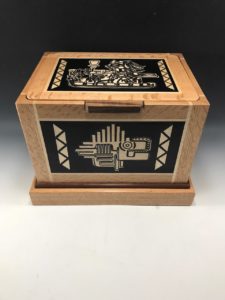 Scott Meyer seemed destined to be a woodworker, from the first time he set foot in a woodshop class in junior high school. Mechanical designer by day and busy woodworker by night, Scott has produced some unique and beautiful designs— particularly intricate boxes, which have become his specialty—over the years in his shop. A few years ago, after his wife’s prompting, Scott dipped his toe in the water of juried art shows, and he hasn’t looked back since. Read on to learn more about this talented artist!
Scott Meyer seemed destined to be a woodworker, from the first time he set foot in a woodshop class in junior high school. Mechanical designer by day and busy woodworker by night, Scott has produced some unique and beautiful designs— particularly intricate boxes, which have become his specialty—over the years in his shop. A few years ago, after his wife’s prompting, Scott dipped his toe in the water of juried art shows, and he hasn’t looked back since. Read on to learn more about this talented artist!
Tell me about yourself.
I grew up in a blue collar neighborhood, north of Detroit. I took woodshop, which was held in the basement of our junior high school, in the seventh grade. I really liked it. I had this little voice in my head telling me that this was what I was going to do with all my free time, for the rest of my life. When my wife and I got engaged, I remember saying to her, “When we buy a house, I hope you never plan on putting a car in the garage.”
So I take it your woodshop has always been in the garage?
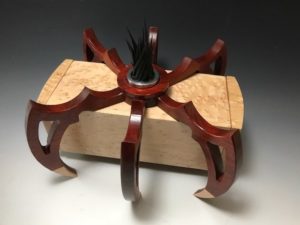 Yes. I live out in Chapel Ridge, in a house that has a three-car garage. We moved out here six years ago from Apex. I have a funny little anecdote about our house. It has a big two-car garage door and then a smaller garage door. I told my wife she could finally put her car in the garage on the smaller side, and that I wouldn’t put any machinery in that part. After we’d been in the house for about a month, she asked me to move some boxes out of the way so she could finally put her car in the garage. After a few minutes, she came back into the house and said, “You know, I lined the car up, and I don’t think it’s gonna fit.” I went outside and looked, and then pulled the tape measure out – it was only eight feet. So I went back in the house and Googled it. Turns out it’s a golf cart door.
Yes. I live out in Chapel Ridge, in a house that has a three-car garage. We moved out here six years ago from Apex. I have a funny little anecdote about our house. It has a big two-car garage door and then a smaller garage door. I told my wife she could finally put her car in the garage on the smaller side, and that I wouldn’t put any machinery in that part. After we’d been in the house for about a month, she asked me to move some boxes out of the way so she could finally put her car in the garage. After a few minutes, she came back into the house and said, “You know, I lined the car up, and I don’t think it’s gonna fit.” I went outside and looked, and then pulled the tape measure out – it was only eight feet. So I went back in the house and Googled it. Turns out it’s a golf cart door.
Have you met any of the other artists who live in Chapel Ridge?
I’ve met Ric from Ric’s Leather and Steevie Parks, the abstract painter. In fact, Steevie, Ric, and I collaborated on a postcard promoting the Chatham Artists Guild Studio Tour this year that we put in everybody’s mailbox in our community a week before the show. I think that had something to do with how many people stopped by. It was Steevie’s idea, and she had the cards printed up. We divided the whole subdivision and got the cards distributed.
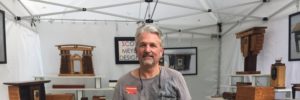
What were your first pieces that you made in your shop?
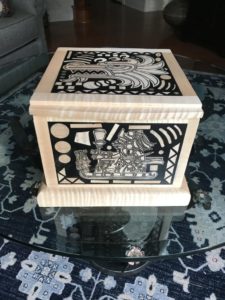 We started our family in Michigan, north of Detroit. I built a garage in the backyard just for my shop. I started off building my kids’ toys, and that morphed into furniture for a while. Then we moved to Florida. One night while we were living in Florida, I stopped at a Barnes and Noble and picked up a book on how to make exotic wood boxes. It just spoke to me, all of those beautiful boxes made out of exotic wood, all these different colors that are all natural. I’ve been obsessed with boxes for about 30 years.
We started our family in Michigan, north of Detroit. I built a garage in the backyard just for my shop. I started off building my kids’ toys, and that morphed into furniture for a while. Then we moved to Florida. One night while we were living in Florida, I stopped at a Barnes and Noble and picked up a book on how to make exotic wood boxes. It just spoke to me, all of those beautiful boxes made out of exotic wood, all these different colors that are all natural. I’ve been obsessed with boxes for about 30 years.
I have a new line I’m doing with resin incorporated into the wood pieces, which morphed out our interest and collection of contemporary NICA pottery. It’s really cool stuff. I have a couple of vessels on my coffee table in my family room, and one night I was really looking at them closely. One has a Mayan border, small mosaic pieces around it, and the background was painted black. I thought, “Hey, I could do this style on boxes.” I built the first one about a year ago, and I’ve been building those ever since.
What draws you to designing and building boxes?
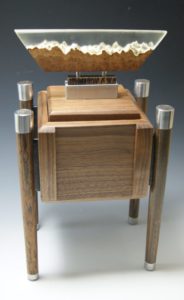 When I saw the pictures in the book, something clicked with me. My wife and I have been going to art shows for close to 40 years, and we like to buy art. For a long time, I kept telling my wife, “I’m going to sign up and sell boxes at art shows.” About four years ago, she got tired of hearing about it and said, “Stop talking about it, and go do it!” So I applied to the Festival on the Eno jury show four years ago and got accepted, which was so exciting. I bought a tent for my displays, and I set up my first show.
When I saw the pictures in the book, something clicked with me. My wife and I have been going to art shows for close to 40 years, and we like to buy art. For a long time, I kept telling my wife, “I’m going to sign up and sell boxes at art shows.” About four years ago, she got tired of hearing about it and said, “Stop talking about it, and go do it!” So I applied to the Festival on the Eno jury show four years ago and got accepted, which was so exciting. I bought a tent for my displays, and I set up my first show.
I was really nervous. The first time you do an art show is nerve-wracking. Three juror artists came by the booth, and I explained how I make my boxes. My wife told me that when I turned my back to pick up a box, one juror looked at one of the others and mouthed the word, “Wow.” When they left, my son and wife said, “You’re gonna win.” I remember saying that woodworkers never win. But I actually went on to win Best in Show!
I remember when I did that very first show, there was a potter set up next to me, who told me he’d been doing this for 30 years. Before the show, he came over, looked at my work, and said, “I’ve been doing this a long time, and I’ve never seen work like yours. I think you could probably get into almost any show you apply for because your work is really unique.” I hear that from a lot of people when I do shows. I’ve discovered that people really like intricate boxes.
After that show, I started doing three or four art shows a year, including Artsplosure, where I won an award of merit. I joined the Chatham Artists Guild about two years ago, right before COVID hit. I did my first Chatham Artists Guild Studio Tour in my open studio in my driveway last year. Unfortunately, hardly anyone came because of COVID, but this year, I had a really good turnout on both weekends.
A couple of years ago, I went back to my old stomping grounds in Michigan and did an art show in Rochester, north of Detroit, which was really fun. I ran into about two dozen people from high school that I hadn’t seen in about 35 years.
So you’re a mechanical designer by trade?
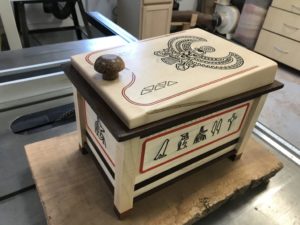 Yes. I started on the drawing board in 1980, designing welding fixtures for General Motors in Detroit. When that industry started going down the tubes, we moved to Florida, where I went to work for a Swedish company, designing sawmill equipment. That was where I started working on AutoCAD, which I did for about 25 years. About 15 years ago, I started to migrate into 3D modeling. Right now, I’m doing a contract job in Charlotte with a company modeling large piping, pumps, and vessels for co-generation plants, where they take natural gas and make electricity.
Yes. I started on the drawing board in 1980, designing welding fixtures for General Motors in Detroit. When that industry started going down the tubes, we moved to Florida, where I went to work for a Swedish company, designing sawmill equipment. That was where I started working on AutoCAD, which I did for about 25 years. About 15 years ago, I started to migrate into 3D modeling. Right now, I’m doing a contract job in Charlotte with a company modeling large piping, pumps, and vessels for co-generation plants, where they take natural gas and make electricity.
I saw some of your inventions are patented – is that right?
Yes. When I worked for the Swedish company, we installed disposable knife systems in huge wood chippers at paper mills. When we got a new president, who used to be our sales manager, he wanted me to see if I could design these disposable knife systems in chipping heads at sawmills. So I started designing chipping heads to put in machines. It worked really well right from the beginning. Today, that product is used in about 80% of their North American market. Probably half to a third of new homes today were built with lumber that was milled by the machine with the chipping head I designed, which quickly turns a whole log into lumber.
Do you think your background as a mechanical designer led to your woodworking career?
Oh, yes. It’s almost like my profession was setting me up to do my artwork. I’ve always enjoyed the design field. I’ve been in it for 40 years. My wife says I’m a strange duck, because I like Sunday nights since I know I can go to work the next day and play. I’m not a workaholic, but I’ve always really enjoyed designing things. I enjoy working in CAD. When we got into 3D modeling on the screen, I took to that like a duck to water. It very much lent itself to my designs and doing the art shows.
I saw on Instagram that you made a surfboard for your son. What was that like?
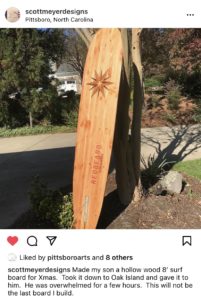 Doing something different from what you are used to doing can be nerve-wracking, especially because surfboards are totally different and large. It looks nice, but it’s as heavy as a tank. He took it out once to try it and just said, “It’s beautiful. I love it.” But he then said it was a wall hanger—it’s displayed in his home. It was a lot of fun to make.
Doing something different from what you are used to doing can be nerve-wracking, especially because surfboards are totally different and large. It looks nice, but it’s as heavy as a tank. He took it out once to try it and just said, “It’s beautiful. I love it.” But he then said it was a wall hanger—it’s displayed in his home. It was a lot of fun to make.
What other offbeat things have you made besides the surfboard?
I’ve made some of the furniture in our house. I made my wife a jewelry box—it’s more like a case—that is taller than her. When we first got married, and we were living in Michigan, before I built the garage woodshop, I took a weekly woodworking class at night. It was held at the local high school, where you have access to all of their machines in the wood shop. It was in that class that I built her a grandfather clock. It’s still in our home today. Picture me, with the clock half-built, putting it in the backseat of a Maverick with the window down in the winter. I bought a set of blueprints, and I made it out of pine. That’s all I could afford.
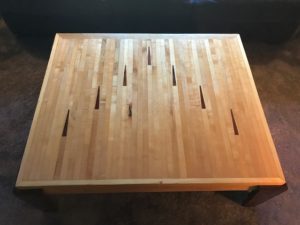 I’ve also got a piece of furniture that I made out of salvaged bowling alley wood. I bought the wood when a bowling alley in Florida went out of business. I made a large coffee table out of it. The wood is from the beginning of the lane where you lay the ball down, with the walnut arrows. Even though it’s rock-hard maple, if you look really closely down at the tabletop, you see all the dents in it from the bowling balls. When my adult children come over, they argue over who gets the table when I’m gone.
I’ve also got a piece of furniture that I made out of salvaged bowling alley wood. I bought the wood when a bowling alley in Florida went out of business. I made a large coffee table out of it. The wood is from the beginning of the lane where you lay the ball down, with the walnut arrows. Even though it’s rock-hard maple, if you look really closely down at the tabletop, you see all the dents in it from the bowling balls. When my adult children come over, they argue over who gets the table when I’m gone.
But I never get tired of making boxes, and I’m always on the lookout for new ideas. I’ve started dabbling with boxes that have secret locking mechanisms. During the Chatham Artists Guild Studio Tour that I participated in earlier this month, I had a couple boxes for sale with the secret locks, and I sold both of them. When people came through the booth and saw the secret locking mechanisms, it made their faces light up. I’m going to explore that a lot more.
What types of woods do you like to work with?
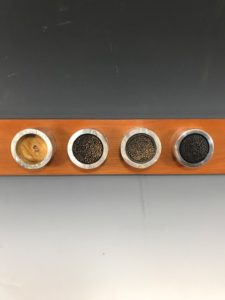 I’ve got about a dozen favorites. If you look at my website, you notice the round medallions on the boxes – I make those out of aluminum pipe and Black Palm wood. It’s one of my favorite woods. Since I get so many questions about the medallions, I actually made a storyboard with four different pieces of the pipe on it, showing the process from beginning to end, step by step, how I make these medallions. When I go to shows, I take the storyboard with me. They also ask about the Black Palm wood, so I take a chunk of it with me to the shows and let people hold it. It’s a very heavy and dense wood. A lot of it comes from Southeast Asia.
I’ve got about a dozen favorites. If you look at my website, you notice the round medallions on the boxes – I make those out of aluminum pipe and Black Palm wood. It’s one of my favorite woods. Since I get so many questions about the medallions, I actually made a storyboard with four different pieces of the pipe on it, showing the process from beginning to end, step by step, how I make these medallions. When I go to shows, I take the storyboard with me. They also ask about the Black Palm wood, so I take a chunk of it with me to the shows and let people hold it. It’s a very heavy and dense wood. A lot of it comes from Southeast Asia.
I was reading that you also have a teaching gig at the Sawtooth School. How did that come about?
When we moved to Chatham County, I reached out to the Sawtooth School and talked to the director of the wood department. He thought there was a good slot open to teach a class on boxes. I really enjoy teaching. It’s very gratifying.
What’s on the horizon for you?
I never want to stop learning. Recently, I bought a new three axis CNC machine to augment what I’m doing, so I’m learning that right now. My whole life has led me down this path. I’m almost ready to retire. If we can just get past COVID, I’m ready to get back into the shows. My wife says I’m an artist. I think I’ve finally gotten there in my mind. I tell myself, “I AM an artist.” Wood is my medium.


Wonderful interview! Scott Meyer sounds like both an incredible artist, and an all around good human. We are fortunate to have him in Chatham. Can’t wait to see his art in person, and possibly get one of his beautiful boxes.
Your stuff is fantastic! You are creatively gifted, I believe. The CNC router isn’t overly difficult. I’m sure you’ll master it in not time. I built a 3×4 CNC router from scratch and I don’t use half it’s capabilities. I think you will do great things with the CNC router and all of your already exceptional abilities. Looking forward to seeing your new stuff as well.